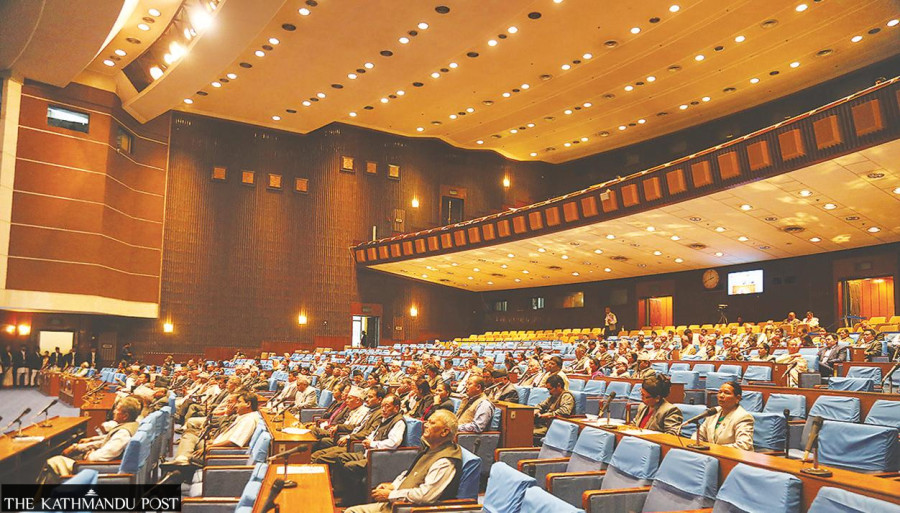National
Revival of women’s caucus vital to advancing feminist movement
The sorority in the 2008 Constituent Assembly laid foundation for gender equality in the constitution.
Aakriti Ghimire
As Nepal gears for its upcoming federal elections, there’s rising tension in the air. Decisions are being made as to who will get to contest directly and who shall get nominated under proportional representation.
Parliamentarians who are women are lobbying and advocating, loud and hard, to ensure their representation in Parliament under direct elections, given the systemic marginalisation of women candidates in the local level elections.
“Because of alliance politics, women’s candidacy fell low in the local level elections. We don’t want that repeating in the federal and provincial elections,” said Kamala Roka, a directly elected Maoist Centre lawmaker.
“Parliamentarians across the political spectrum who are women raised the issue that 50 percent of the first-past-the-post candidates should be women.”
Experts say the major hindrance to women's representation and women’s issues in Parliament has been the political parties themselves.
The male-dominated structure of political parties has sidelined, suppressed and marginalised the voices of women in Parliament. Despite their solidarity in raising crucial social issues, in the lack of a women’s caucus—a cross-party interest group of women—in the current federal parliament, women’s issues are in one ear and out the other, parliamentarians say.
“Take the statute of limitations on rape in the case of a minor, for instance: Women fought hard in their own political parties in their individual capacities and they even passed a resolution motion in the National Assembly for a removal of the statute of limitations on such heinous crimes,” says Bimala Rai Paudyal, an independent member of the National Assembly.
“But at the end of the day, the bill that was passed only increased the time limit [for bringing a rape case] despite our demand that it be scrapped altogether.”
Had there been an organised women’s caucus in Parliament, similar to the Constituent Assembly (CA) formed in 2008, issues concerning gender equality would have been prioritised, Paudyal says.
The caucus was a platform for women from across the parties to come together and collectively influence women’s agenda. The women put aside their ideological differences, which gave way for the issues of gender equality to take precedence over the divisive nature of the political parties, experts say.
The women CA members formed a caucus of 197 members from the then 19 political parties on 2 January 2009. The caucus had a steering committee of 24 members from the parties that had women members.
The leadership of the caucus was rotated every four months among its members. The convenors were Dama Sharma from the then UCPN (Maoist), Mohamaddi Siddiqui of the Nepali Congress, Usha Kala Rai from the CPN-UML, and Neelam Verma from the Madheshi Janadhikar Forum Loktantrik, to name a few.
The caucus, however, was never accorded a formal status on the grounds that if it was, other marginalised groups like Dalits and Janajatis would demand the same.
The caucus’s priorities ranged from developing a concept paper on women's rights in the new constitution, promoting and encouraging women's participation in the peace process, advocating inheritance rights, and proportional inclusive representation to equality in citizenship.
Parliamentarians were organised, united and dedicated to seeing through their agendas despite differences in party affiliation, according to Roka.
“We lobbied hard to ensure women’s one-third representation in not just the legislative but also the executive, judiciary and political parties,” said Roka, who was a member of the women’s caucus in the 2008 CA. “As we were transitioning to the federal model, we also successfully lobbied to constitutionally ensure women’s representation in the local and provincial levels of government.”
The women’s caucus was crucial to ensuring a woman’s representation as either the mayor or deputy mayor and also a Dalit woman representative in local governments. Additionally, it played an important role in increasing the statute of limitations on rape from 35 days to 180 days, experts say.
Former election commissioners say the caucus laid foundations for provisions of gender equality in the Constitution of Nepal, 2015.
Despite such pivotal contributions made by the women’s caucus, it was discontinued after the dissolution of the first CA.
Threatened by the influence of parliamentarians who are women, the male politicians banned the formation of caucuses thereafter, experts say.
“They [women’s caucus] had such strong bargaining power. They were working together. There was a gravity. And the political leadership felt threatened by such powers,” said Bhojraj Pokhrel, a former chief election commissioner. “The powers in Parliament are with men only. Enmeshed in patriarchy for decades, political parties did not do justice to women.”
The key hurdle women in Parliament faced was their own political parties. In addition, women also had to balance their party interests alongside their agendas related to women, which caused them difficulties in balancing their efforts, experts say.
“The caucus had many advantages but these women also shouldered the burden of correcting everything and being active on all fronts,” says Ila Sharma, a former election commissioner. “They were not just women in the caucus, they were also members of the party hierarchy who had to act according to party interests as well.”
Gender experts who have observed the women’s caucus closely say that patriarchy and party politics solely weren’t the reasons for the demise of the caucus. Women in the caucus experienced burnout and felt demotivated because of the pressure they experienced from many sides, they say.
Sucheta Pyakuryal, director of the Center for Governance at IIDS (Institute for Integrated Development Studies), points out a host of reasons that contributed to the death of women’s caucus—they include, in her words, “collective pressures of toxic residual politics, non-alignment with the visions and goals of the caucus, a dearth of leadership and ego tussle among the members of the sorority created by an unhealthy competition for funds and resources provided by international organisations.”
While gender experts acknowledge the role of international donors and organisations in establishing the caucus, mentoring and providing exposure to the women in Parliament, they add that their intervention hindered an organic and independent existence of the caucus.
Had the caucus been allowed to evolve organically, maybe women in Parliament would have found a way out, said Pyakuryal.
Research also shows that the women representatives were not only divided along
party lines but also along caste, ethnicity, class and language.
Despite a plethora of reasons that led to the slackening of the women’s caucus and left women demotivated to fight for its existence in the second Constituent Assembly, gender experts say that the women in Parliament need to be proactive in establishing a women’s caucus in the upcoming Parliament.
“Women’s caucus is a torchbearer of feminist movement in Nepal,” Pyakuryal said. “If we have established a women’s caucus before, we can do it again. Saying ‘they didn’t let us do it’ will be an excuse. How and when can we hold our female parliamentarians accountable?”
Parliamentarians the Post talked to said that a lot of work is yet to be done to ensure the essence of inclusivity and gender equality guaranteed in the Constitution. To do so, they say, it is crucial to have a women’s caucus in the legislature to be formed after the November 20 polls.
“Our laws do not align with the constitution yet. In order to ensure the effective implementation of the constitution, we need to make laws. For instance, there are still a lot of issues with getting citizenship from a mother’s name,” said Roka, the Maoist Centre lawmaker. “We will need a women’s caucus to get organised, set agendas and raise our voices.”




 16.35°C Kathmandu
16.35°C Kathmandu








%20(1).jpg&w=300&height=200)






